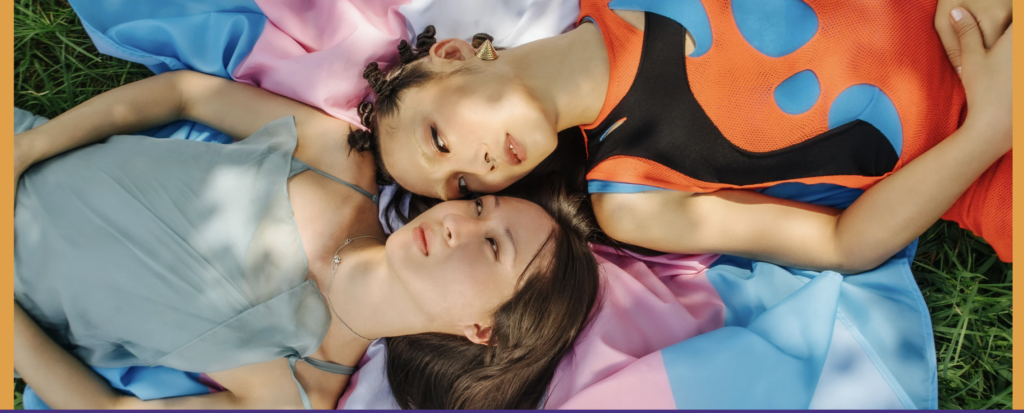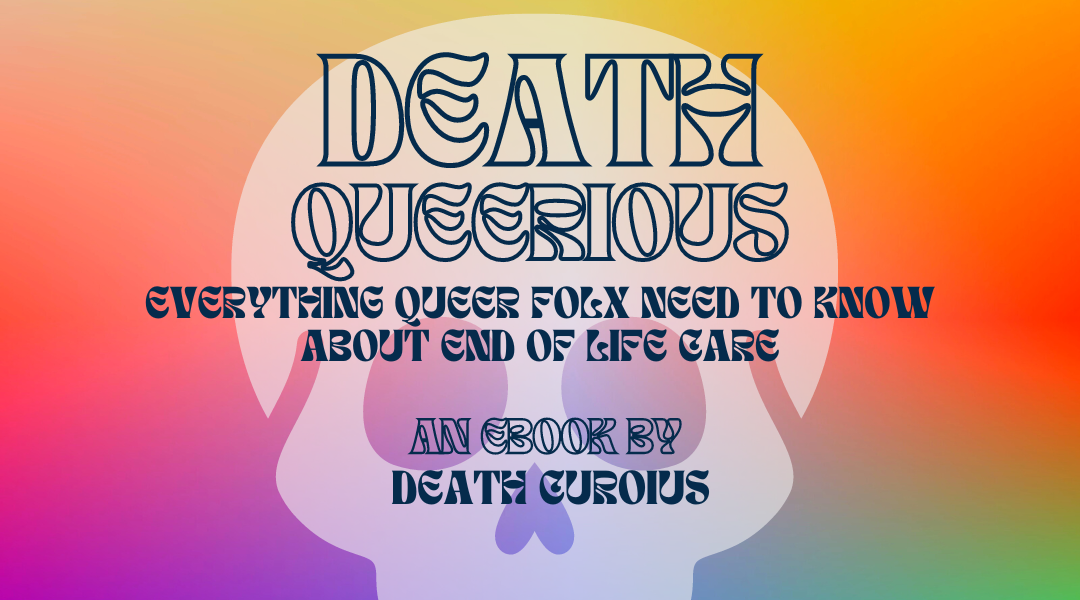Death isn’t easy to talk about, and our current death care and end of life systems and laws, like many other institutions in the US, don’t protect the rights of queer and trans folx. It’s important for everyone to think ahead about end of life decisions, make a plan, and make it legal, so we can protect ourselves and the people we love. Being prepared in this way is especially important for marginalized populations like the 2SLGBTQIA+ community whose wishes and identities might be in jeopardy after death due to outdated and discriminatory laws. Queer death care is vital because when queer folx are prepared and know how to plan for a good death we can feel relief knowing that our identities, the things we care about, and our family (chosen or otherwise) will be protected when the time comes.
How Does Death Avoidance Impact Queer Death Care?
Death avoidance
Here’s the thing: Death is the only thing in this world guaranteed to happen to every single living being. No one can escape it. And that thought is absolutely terrifying. Facing our own mortality, the mortality of everyone we love, and the ephemeral nature of being is hard.
Because Death is scary and is hard to directly confront, many of us unfortunately experience pervasive cultural taboos around talking about death or even thinking about death. Death isn’t a part of our everyday lives in modern culture, like it was before the early 20th century. This removal of death from our every-day has led to a phenomenon that sociologists, historians, and anthropologists call Death Avoidance. Death avoidance refers to conscious or unconscious behaviors, beliefs, and attitudes individuals adopt to avoid thoughts and reminders of death. Death avoidance can have negative effects on the human psyche. While it is a common and natural response, excessive or maladaptive death avoidance strategies can hinder psychological well-being and personal growth.
Death avoidance has intense real-world implications like personal anxiety, frustration with living family members who are unwilling to talk about end of life issues, harmful end of life care for marginalized populations like queer, trans, and bipoc folx, distanced relationships from people we love, and lack of good, personal death planning, as well as larger negative societal impacts. These problems result in disappointing memorials, self-doubt about end of life decisions we make for our loved ones, disenfranchised and complicated grief, and grief avoidance. When we don’t talk about death, we find ourselves unprepared for it, when it inevitably comes. This avoidance and lack of preparation can have specifically harmful impacts on the queer community, because our relationship to and traumatic history of violent death due to homophobia and discrimination is difficult and complex. When everyone is afraid to talk about death, those of us who face the reality of it regularly and have traumatic experiences with it, can’t get the grief and end-of-life support that we need. This can lead to isolation, complicated grief, and compounded negative mental and emotional repercussions. Resources that are by LGBTQIA+ folx, for LGBTQIA+ folx will go a long way towards making queer death care more accessible for all.

Why Do LGBTQIA+ Folx Need Specialized Queer Death Care??
For the 2SLGBTQIA+ community, who currently exist in the world alongside many people who would happily see our existence snuffed out, the topic of death is extremely complex, and can often bring up additional trauma. Thus, the problem of death avoidance can be particularly relevant and more nuanced. Put bluntly, queer and trans people have shorter life expectancies on average, due to being statistically more likely to face violence, discrimination-based trouble seeking medical care, and other societal factors. These issues, coupled with pervasive death avoidance in wider culture make death more present in our lives, while simultaneously depriving us of safe spaces and resources to talk about and learn about death care, end of life care, and grief support.
Elevated Rates of Violence and Assault
For years, data and research have shown that queer people are far more likely to be the victims of violent crimes, including murder. According to this article from the Prison Policy Initiative, “LGBT people — and particularly young adults, people of color, women, and bisexual people — are at heightened risk of violent victimization compared to their straight and cisgender counterparts.” Awareness of this fact makes the threat of death a more ever-present part of our lives, and thus, might make queer folx more resistant to spending time thinking about death planning and preparation
The HIV/AIDS Epidemic
The AIDS epidemic and the disproportionate number of deaths it caused in the LGBTQIA+ community led to widespread generational trauma among queer folx. Looking back now, we know that there was a blatant lack of care and action taken by the US government to stop AIDS because of homophobic ideologies. Queer folx, particularly gay and bisexual men, and trans women, were impacted by AIDS at a significantly higher rate than other populations. Since many straight/cis nurses and doctors refused to treat homosexual AIDS patients, lesbian nurses now known as “the blood sisters” stepped up and cared for the dying queer population in AIDS wards across the US. Thus, during the AIDS crisis, the entire LGBTQIA+ community was faced with grizzly, horrific death day in and day out.
Furthermore, the AIDS epidemic caused a whole generation of the LGBTQIA+ community to have a diminished life expectancy for decades. This article from the National Library of Medicine explains just how shortened the life expectancy of gay and bisexual men was in the mid 1990’s:
“[L]ife expectancy at age 20 years for gay and bisexual men is 8 to 20 years less than for all men. If the same pattern of mortality were to continue, we estimate that nearly half of gay and bisexual men currently aged 20 years will not reach their 65th birthday. Under even the most liberal assumptions, gay and bisexual men in this urban centre are now experiencing a life expectancy similar to that experienced by all men in Canada in the year 1871.”
Healthcare Discrimination
Additionally, due to continued discrimination in healthcare spaces, and stigma and prejudice around gender affirming care, many queer folx resist or put off seeking basic medical help on a regular basis. This means that minor health problems are more likely to become larger, potentially life-threatening health concerns among the LGBTQIA+ population. Common life threatening concerns for queer and trans folx like suicidality, HIV, etc. often go untreated, and there have been many reports of queer patients with these health concerns being turned away from medical facilities simply for being queer.
It is far more common for queer folx to experience health care providers not believing them, dismissing concerns, and making assumptions about their health.
This article from the Guttmacher Institute highlights just one of the many potentially fatal consequences of queer folx having challenging barriers to healthcare: “Other research has found queer women do not access routine preventive screenings for breast cancer and cervical cancer at the same rate as their straight peers. These differences in perception and action regarding sexual and reproductive health services can lead LGBTQ individuals to have fewer diagnoses and treatments than their straight counterparts.”
Transness and Death Care
According to the HRC 2021 was the most deadly year for trans and genderqueer folx ever, since they began recording trans violent deaths in 2013 and the majority of these deaths were BIPOC trans women, “Sadly, 2021 has already seen at least 57 transgender or gender non-conforming people fatally shot or killed by other violent means. We say at least because too often these stories go unreported — or misreported. In previous years, the majority of these people were Black and Latinx transgender women. In 2020, HRC tracked a record number of violent fatal incidents against transgender and gender non-conforming people. A total of 44 fatalities were tracked by HRC, marking 2020 as the most violent year on record since HRC began tracking these crimes in 2013. These victims, like all of us, are loving partners, parents, family members, friends and community members. They worked, went to school and attended houses of worship. They were real people — people who did not deserve to have their lives taken from them.”
Many experts agree that legislation against trans rights, including bathroom bills, sports rulings, and now the atrocious public school bills popping up in Florida, Texas and other states have a harmful impact by misinforming the public about who trans folx are, and creating stigmatization around the LGBTQIA+ community. Not only do these bills have negative consequences for trans folx, experts believe that these bills actually lead to more violent attacks against that community. According to an article from CBS News, “2021 was the deadliest year yet for those who are transgender or non-binary, with at least 47 people killed since January 1[…] The year of deadly violence comes after a surge in legislation seeking to limit access to sports and health care for transgender children[…] Between the start of 2020 to April of this year, more than 75 bills specifically targeted transgender youth were introduced. Several more have been proposed since.”
With the “LGBTQIA+ Panic Defense” still being used in courts today to heinously excuse the violence perpetrated against the trans community, violence and death continue to be an escalating problem.
According to more research, while it is a fact that trans and nonbinary people are more likely to be the victim of violent crimes and homicide, according to research, they are also a demographic that is very vulnerable to death by suicide. One study found that 69% of the trans deaths reported in the study were due to suicide, with contributing factors including discrimination, family rejection, internalized transphobia, and being denied appropriate bathroom or housing access.

Nonconsensual De-gendering
It is a sad fact that the trans community faces an elevated threat of violence and death, which makes specialized care for our community within the deathcare profession even more important. However, trans folx are the most vulnerable population to abuse and mistreatment after death. In addition to being the victims of escalating violent crimes, trans folx also commonly deal with difficult relationships with family of origin. Often, if a trans person’s family of origin is still legally listed as their “next of kin” that family has the right to de-gender, or de-transition the deceased, leading to funeral viewings, death certificates, and memorial markers in which the deceased person’s dead name and incorrect gender are used and physically presented. This specific type of abuse is called “non-consensual degendering” in funeral homes, and is a real threat to the trans community if legal precautions aren’t taken during a person’s lifetime.
This article outlines just how common nonconsensual degendering is among the trans/nonbinary population: “In their paper,Transgender and Nonbinary Deaths Investigated by the State Medical Examiner in the Portland, Oregon, Metro Area and Their Concordance with Vital Records, […] the researchers found that more than half of transgender and non-binary people who died during this time period were misgendered on their death certificates.”
These challenges, coupled with outdated laws about next of kin and funeral planning can make death planning much more difficult for the genderqueer and trans community than it already is for everyone else.
Queering Death Care
It’s clear that many societal factors contribute to the tangible threat of violence and death in the lives of many queer and trans people. When combined with the widespread problem of death avoidance that exists in American culture, it’s easy to see why the 2SLGBTQIA+ community needs special consideration and attention when it comes to queer death care.
Queer Death Care: Building A Healthier Relationship with Mortality
Research shows that having a healthy relationship with our mortality can actually lead to a happier, more fulfilled life. A recent study from Science Daily revealed that, “Thinking about death can actually be a good thing. An awareness of mortality can improve physical health and help us re-prioritize our goals and values[…]. In constructing a new model for how we think about our own mortality, Vail and colleagues performed an extensive review of recent studies on the topic. They found numerous examples of experiments both in the lab and field that suggest a positive side to natural reminders about mortality.” This research found that normalizing thinking about and talking about death in our daily lives in healthy ways can lead to a higher inclination to help others, making choices that are better for the environment, and living healthier lifestyles.
From the ever-present threat of violent death from assault, to the AIDS epidemic, to difficulty accessing safe medical care, queer folx have had to deal with the looming possibility of early death as a very dark and tangible part of our lives throughout history. This has also led to exponential amounts of grief in our community. Since very few people in our modern culture are comfortable talking about death and grief, or know how to approach these topics in a healthy way, the problems of grief and death avoidance continue to compound, especially in the queer community. Today, this can make death an extremely sensitive and difficult topic to approach and talk about in healthy ways. This problem leaves our community vulnerable when it comes to planning a good death, and having a healthy relationship with our mortality… both of which can concretely improve quality of life.
Queer Death Care: Access to Better Death Education
Access to Better Death Education
Since the LGBTQIA+ community already faces social challenges like discrimination, prejudice, and difficulty accessing proper healthcare among other things, it’s even more important that we have access to resources which can help us avoid additional psychological stressors like death avoidance. The LGBTQIA+ community deserves good, safe, queer death care, end of life support, and proper respect and treatment after death. Empowering our community with knowledge and resources in order to access safe spaces at end of life, and choose the death care and funeral care options that will best serve each of us is vital. That’s why I have put together the free ebook “Death Queerious: Everything You Need to Know about Queer End of Life Care”
Death Queerious is a resource for helping the 2SLGBTQIA+ community plan for a good death. For all of the reasons outlined here, it’s important to know what you want, make a plan, and make it legal, so that your identity, and your family (chosen or otherwise) will be prepared when the time comes. The information found in Death Queerious will help queer folx access the knowledge and resources that we need to plan ahead and ensure a good death for ourselves, and loved ones in the years ahead.



